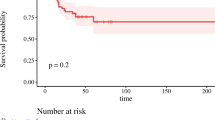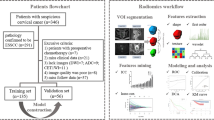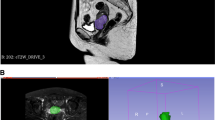Abstract
Objectives
To develop and validate a clinical-radiomics model that incorporates radiomics signatures and pretreatment clinicopathological parameters to identify multimodality therapy candidates among patients with early-stage cervical cancer.
Methods
Between January 2017 and February 2021, 235 patients with IB1-IIA1 cervical cancer who underwent radical hysterectomy were enrolled and divided into training (n = 194, training:validation = 8:2) and testing (n = 41) sets according to surgical time. The radiomics features of each patient were extracted from preoperative sagittal T2-weighted images. Significance testing, Pearson correlation analysis, and Least Absolute Shrinkage and Selection Operator were used to select radiomic features associated with multimodality therapy administration. A clinical-radiomics model incorporating radiomics signature, age, 2018 Federation International of Gynecology and Obstetrics (FIGO) stage, menopausal status, and preoperative biopsy histological type was developed to identify multimodality therapy candidates. A clinical model and a clinical-conventional radiological model were also constructed. A nomogram and decision curve analysis were developed to facilitate clinical application.
Results
The clinical-radiomics model showed good predictive performance, with an area under the curve, sensitivity, and specificity in the testing set of 0.885 (95% confidence interval: 0.781–0.989), 78.9%, and 81.8%, respectively. The AUC, sensitivity, and specificity of the clinical model and clinical-conventional radiological model were 0.751 (0.603–0.900), 63.2%, and 63.6%, 0.801 (0.661–0.942), 73.7%, and 68.2%, respectively. A decision curve analysis demonstrated that when the threshold probability was > 20%, the clinical-radiomics model or nomogram may be more advantageous than the treat all or treat-none strategy.
Conclusions
The clinical-radiomics model and nomogram can potentially identify multimodality therapy candidates in patients with early-stage cervical cancer.
Key Points
• Pretreatment identification of multimodality therapy candidates among patients with early-stage cervical cancer helped to select the optimal primary treatment and reduce severe complication risk and costs.
• The clinical-radiomics model achieved a better prediction performance compared with the clinical model and the clinical-conventional radiological model.
• An easy-to-use nomogram exhibited good performance for individual preoperative prediction.





Similar content being viewed by others
Abbreviations
- AC:
-
Adenocarcinoma
- ASC:
-
Adenosquamous carcinoma
- AUC:
-
Area under the curve
- CIs:
-
Confidence intervals
- FIGO:
-
International Federation of Gynecology and Obstetrics
- LASSO:
-
Least Absolute Shrinkage and Selection Operator
- LNM:
-
Lymph node metastasis
- LoG:
-
Laplacians of Gaussians
- LVSI:
-
Lymphovascular space invasion
- PMI:
-
Parametrial invasion
- ROC:
-
Receiver-operating characteristic
- SCC:
-
Squamous cell carcinoma
References
Sung H, Ferlay J, Siegel RL et al (2021) Global cancer statistics 2020: GLOBOCAN estimates of incidence and mortality worldwide for 36 cancers in 185 countries. CA Cancer J Clin. https://doi.org/10.3322/caac.21660
Sartori E, Tisi G, Chiudinelli F, La Face B, Franzini R, Pecorelli S (2007) Early stage cervical cancer: adjuvant treatment in negative lymph node cases. Gynecol Oncol 107:S170-174
Doll K, Donnelly E, Helenowksi I et al (2011) Treatment of stage IB1 cervix cancer: comparison of radical hysterectomy and radiation. Gynecol Oncol 123:444
Gemer O, Lavie O, Gdalevich M et al (2016) Evaluation of clinical and pathologic risk factors may reduce the rate of multimodality treatment of early cervical cancer. Am J Clin Oncol 39:37–42
Shu T, Zhao D, Li B et al (2017) Prognostic evaluation of postoperative adjuvant therapy for operable cervical cancer: 10 years’ experience of National Cancer Center in China. Chin J Cancer Res 29:510–520
Baalbergen A, Veenstra Y, Stalpers LL, Ansink AC (2010) Primary surgery versus primary radiation therapy with or without chemotherapy for early adenocarcinoma of the uterine cervix. Cochrane Database Syst Rev. https://doi.org/10.1002/14651858.CD006248.pub2:Cd006248
Rogers L, Siu SS, Luesley D, Bryant A, Dickinson HO (2012) Radiotherapy and chemoradiation after surgery for early cervical cancer. Cochrane Database Syst Rev 5 Cd007583
Saleh M, Virarkar M, Javadi S, Elsherif SB, de Castro FS, Bhosale P (2020) Cervical cancer: 2018 Revised International Federation of Gynecology and Obstetrics Staging System and the Role of Imaging. AJR Am J Roentgenol 214:1182–1195
Haldorsen IS, Lura N, Blaakær J, Fischerova D, Werner HMJ (2019) What Is the Role of Imaging at Primary Diagnostic Work-Up in Uterine Cervical Cancer? Curr Oncol Rep 21:77
Cibula D, McCluggage WG (2019) Sentinel lymph node (SLN) concept in cervical cancer: current limitations and unanswered questions. Gynecol Oncol 152:202–207
Gillies RJ, Kinahan PE, Hricak H (2016) Radiomics: images are more than pictures, they are data. Radiology 278:563–577
Lambin P, Leijenaar RTH, Deist TM et al (2017) Radiomics: the bridge between medical imaging and personalized medicine. Nat Rev Clin Oncol 14:749–762
Balcacer P, Shergill A, Litkouhi B (2019) MRI of cervical cancer with a surgical perspective: staging, prognostic implications and pitfalls. Abdom Radiol (NY) 44:2557–2571
Wu Q, Wang S, Chen X et al (2019) Radiomics analysis of magnetic resonance imaging improves diagnostic performance of lymph node metastasis in patients with cervical cancer. Radiother Oncol 138:141–148
Xiao M, Ma F, Li Y et al (2020) Multiparametric MRI-based radiomics nomogram for predicting lymph node metastasis in early-stage cervical cancer. J Magn Reson Imaging 52:885–896
Li Z, Li H, Wang S et al (2019) MR-based radiomics nomogram of cervical cancer in prediction of the lymph-vascular space invasion preoperatively. J Magn Reson Imaging 49:1420–1426
Wu Q, Shi D, Dou S et al (2019) Radiomics analysis of multiparametric MRI evaluates the pathological features of cervical squamous cell carcinoma. J Magn Reson Imaging 49:1141–1148
Wang T, Gao T, Guo H et al (2020) Preoperative prediction of parametrial invasion in early-stage cervical cancer with MRI-based radiomics nomogram. Eur Radiol 30:3585–3593
National Comprehensive Cancer Network. NCCN clinical practice guidelines in oncology. Cervical Cancer (Version 1.2020). [cited 2020 Jan 14] Available from: https://www.nccn.org/professionals/physician_gls/pdf/cervical.pdf
Wang M, Xia C, Huang L et al (2020) Deep learning-based triage and analysis of lesion burden for COVID-19: a retrospective study with external validation. Lancet Digit Health 2:e506–e515
Landoni F, Colombo A, Milani R, Placa F, Zanagnolo V, Mangioni C (2017) Randomized study between radical surgery and radiotherapy for the treatment of stage IB-IIA cervical cancer: 20-year update. J Gynecol Oncol 28 e34
Landoni F, Maneo A, Colombo A et al (1997) Randomised study of radical surgery versus radiotherapy for stage Ib-IIa cervical cancer. Lancet 350:535–540
Cibula D, Pötter R, Planchamp F et al (2018) The European Society of Gynaecological Oncology/European Society for Radiotherapy and Oncology/European Society of Pathology guidelines for the management of patients with cervical cancer. Radiother Oncol 127:404–416
Marth C, Landoni F, Mahner S, McCormack M, Gonzalez-Martin A, Colombo N (2017) Cervical cancer: ESMO Clinical Practice Guidelines for diagnosis, treatment and follow-up. Ann Oncol 28:iv72-iv83
Adam JA, van Diepen PR, Mom CH, Stoker J, van Eck-Smit BLF, Bipat S (2020) [(18)F]FDG-PET or PET/CT in the evaluation of pelvic and para-aortic lymph nodes in patients with locally advanced cervical cancer: a systematic review of the literature. Gynecol Oncol 159:588–596
Xiao M, Yan B, Li Y, Lu J, Qiang J (2020) Diagnostic performance of MR imaging in evaluating prognostic factors in patients with cervical cancer: a meta-analysis. Eur Radiol 30:1405–1418
Bourbonne V, Vallières M, Lucia F et al (2019) MRI-derived radiomics to guide post-operative management for high-risk prostate cancer. Front Oncol 9:807
Bourbonne V, Fournier G, Vallières M et al (2020) External validation of an MRI-derived radiomics model to predict biochemical recurrence after surgery for high-risk prostate cancer. Cancers (Basel) 12:814
Balleyguier C, Sala E, Da Cunha T et al (2011) Staging of uterine cervical cancer with MRI: guidelines of the European Society of Urogenital Radiology. Eur Radiol 21:1102–1110
Dimopoulos JC, Petrow P, Tanderup K et al (2012) Recommendations from Gynaecological (GYN) GEC-ESTRO Working Group (IV): Basic principles and parameters for MR imaging within the frame of image based adaptive cervix cancer brachytherapy. Radiother Oncol 103:113–122
Avanzo M, Stancanello J, El Naqa I (2017) Beyond imaging: the promise of radiomics. Phys Med 38:122–139
Park SH, Lim H, Bae BK et al (2021) Robustness of magnetic resonance radiomic features to pixel size resampling and interpolation in patients with cervical cancer. Cancer Imaging 21:19
Vickers AJ, Cronin AM, Elkin EB, Gonen M (2008) Extensions to decision curve analysis, a novel method for evaluating diagnostic tests, prediction models and molecular markers. BMC Med Inform Decis Mak 8:53
Vickers AJ, Van Calster B, Steyerberg EW (2016) Net benefit approaches to the evaluation of prediction models, molecular markers, and diagnostic tests. BMJ 352 i6
Acknowledgements
This work was supported by grants from the Natural Science Foundation of China (grant no. 81901829) and the Fundamental Research Funds for the Central Universities (grant no. 3332019032).
Funding
Natural Science Foundation of China, 81901829, Yong-Lan He, the Fundamental Research Funds for the Central Universities, 3332019032, Yong-Lan He.
Author information
Authors and Affiliations
Corresponding authors
Ethics declarations
Guarantor
The scientific guarantor of this publication is Professor Yong-Lan He.
Conflict of interest
Co-author Ying Cao, Chen Xia, Wen Tang, and Kuan Chen are employees of Beijing Infervision Technology Co. The other authors have no conflicts of interest to disclose. The authors not employed by Infervision Technology Co. were in control of this study.
Statistics and biometry
No complex statistical methods were necessary for this paper.
Informed consent
Written informed consent was waived by the Institutional Review Board.
Ethical approval
Institutional Review Board approval was obtained.
Methodology
• Diagnostic or prognostic study
Additional information
Publisher's note
Springer Nature remains neutral with regard to jurisdictional claims in published maps and institutional affiliations.
Rights and permissions
About this article
Cite this article
Li, Y., Ren, J., Yang, JJ. et al. MRI-derived radiomics analysis improves the noninvasive pretreatment identification of multimodality therapy candidates with early-stage cervical cancer. Eur Radiol 32, 3985–3995 (2022). https://doi.org/10.1007/s00330-021-08463-y
Received:
Revised:
Accepted:
Published:
Issue Date:
DOI: https://doi.org/10.1007/s00330-021-08463-y




